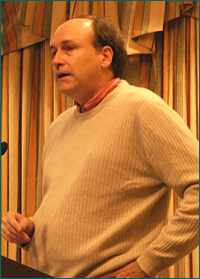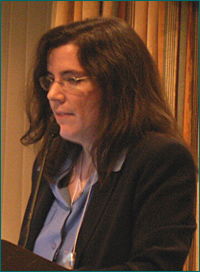PANEL HIGHLIGHTS

Barry Parr, Editor and Publisher, Coastsider.com
Lisa Williams, Founder, H20Town.info
OVERVIEW
Frustrations about lacking mainstream media coverage drive many hyperlocal news start-ups, but the founders of community sites such as H2OTown.info in Watertown, Mass., or Coastsider.com in Northern California say are not trying to reinvent the newspaper.
Instead of serving as web sites of record, these sites aim to build a greater sense of community in the places they live and to help shape the public agenda. Unsatisfied with the label “citizen journalism,” Lisa Williams, founder of H2OTown.info, developed a new term for these online publications: placeblogs.
That does not mean that citizen news sites don’t lead the professional pack at times. When a main connector road to San Francisco washed out in spring 2006, Coastsider.com Editor Barry Parr posted breaking updates on the repair work and saw traffic to his site more than double. Williams said her site had exclusive reports on four major stories in the past month. But, she says, that is not the main goal of a placeblog.
“They are about the lived experience of a place,” Williams said. “And if we’re very lucky, when we walk out the door, our lived experience of a place is not news. If we walk out the door and routinely our experience of a place is news, two things are happening – either you live in a war zone or you are personally a celebrity. … When I look at a placeblog, what I see is the lived experience of people.”
Barry Parr, Editor and Publisher, Coastsider.com,
San Mateo County, Calif.
 “I can still remember the first time I actually interviewed someone,” Barry Parr says. “I am not a journalist by training.”
“I can still remember the first time I actually interviewed someone,” Barry Parr says. “I am not a journalist by training.”
Parr has become a journalist by immersion. When a main road connecting his community of 30,000 in rural San Mateo County, Calif., to San Francisco washed out in April 2006, Parr’s frequent postings on his community news site, Coastsider.com, drove traffic from about 10,000 visitors a month to 40,000 before they settled down to about 20,000.
That makes his weekly visits on par with the 5,000 paid subscribers of the local weekly newspaper.
More recently, he has tangled with local officials in a public records battle over access to videotapes of municipal meetings aired by the local cable provider.
Parr is a media analyst and a former architect of the online news site for the San Jose Mercury News. But as he has become increasingly immersed in community journalism, he also has become a media critic.
“The more I was writing about events in the community that the newspaper was covering, the more I was realizing that there were huge areas that were going uncovered in the paper,” Parr said. The role of his site, he says, is to fill those gaps.
“Breaking news is really a grind for a citizen journalist,” he said.
“My goal now is to focus more on setting the agenda for conversation in the community,” he said. “What are the major issues, what are the factors surrounding those issues and what should we be talking about, as opposed to, what happened last night at the city council meeting?”
Long-term, Parr would love to turn his avocation into a business, but to make that work, Parr said he would need to do a print edition that would bring in advertising revenue that is difficult to get when only publishing online.
Lisa Williams, Founder, H20Town.info,
Watertown, Mass.
 Lisa Williams has an answer for the running debate over what to call hyperlocal news sites and blogs devoted to community events. Scrap the term “citizen journalism,” she says, and think of these sites as “placeblogs.”
Lisa Williams has an answer for the running debate over what to call hyperlocal news sites and blogs devoted to community events. Scrap the term “citizen journalism,” she says, and think of these sites as “placeblogs.”
She defines placeblogs as “an act of sustained attention of a particular place over time.”
Williams also is trying to answer how sites like her own chronicle life in towns across America and assess their influence on the media landscape. She is developing a new site, placeblogger.com, designed as a portal for all web sites dedicated to new models of reporting local news.
Among her early findings:
- Fewer than 1 percent of placeblog readers will become consistent contributors.
- At least 3 percent of the 19,000 incorporated U.S. cities and towns have placeblogs, a number that could grow to 5 percent by the end of 2006.
- Communities with populations of between 20,000 and 70,000 are demographic hotspots for placeblogs, because they often lack dedicated coverage from a mainstream media outlet.
- Placeblogs that are succeeding financially typically exist in places with healthy downtowns – resort areas, college towns or affluent city neighborhoods – with a healthier advertising pool.
Each site, Williams says, also has a distinct voice and attitude that mainstream media outlets covet, but struggle to reproduce.
“People have asked to buy H2OTown, and I don’t want to work for them, because I think they wouldn’t let me make jokes,” Williams said. “I think that a lot of people want the magic that they see in online sites, and then they want to control it. They’re actually kind of scared of it.”
She sees a need to advance blogs so that they don’t house content in reverse chronological order because, she said, “To the community, that’s not very helpful.”
She also sees a need for geo-locating local blogs so that you can search for all the blogs within 20 miles of a particular community. “What you can discover, you can advertise against,” she said.
Jump to other panel summaries:
Panel 1: New Kinds of Hyperlocal Start-ups
Panel 2: Solo-jos with Community Impact
Panel 3: Mainstream Media: Past Lessons, Future Vision
Panel 4: Building Sustainability
Panel 5: Citizen Television Correspondents
First Release: Highlights of Phase 1 Ford-funded study of citizen media projects







